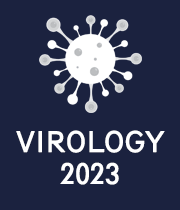Amoroso Maria Grazia , Zooprofilactic and Experimental Institute of Southern Italy, Italy
Abstract: Infective gastroenteritis (GA) represent a world public health relevant problem. Enteric viruses are the pathogens mainly involved in the episodes of GE, causing about 70% of the cases. In Italy most of the GA are not notified because of a mild symptomatology which does [....] » Read More














Title : Regulation of IRF3 functions to control viral infections
Saurabh Chattopadhyay, The University of Toledo, United States
Abstract: We have recently conducted a high throughput screen of an FDA-approved drug library to isolate small molecule regulators of IRF3 activities. IRF3 is a well-known transcription factor for inducing interferon (IFN) genes in response to viral infection. IRF3, upon virus in [....] » Read More
Title : Post-vaccination antibody responses against SARS-CoV-2 in patients with liver cirrhosis. What do we know so far?
Theodoros Androutsakos, National and Kapodistrian University of Athens, Greece
Abstract: Various studies have investigated the severity of coronavirus disease 2019 (COVID-19) in patients with liver diseases (PWLD) since the beginning of the pandemic and patients with cirrhosis seem to have an elevated risk for severe COVID-19 course and death, making vaccin [....] » Read More
Title : Evolutionary trajectory and origin of SARS-CoV-2
Anyou Wang, University of Memphis, United States
Alignment-based phylogenetics fails to uncover the evolutionary trajectory and origin of SARS-CoV-2. This study develops a novel alignment-free system based on Fréchet distance and artificial recurrent neural network to reveal the evolutionary trajectory and origin of SARS [....] » Read More
Title : Robotics in the field of virology
Naveen Khatri, University of Health Sciences, India
The stories of robots started surfacing from the start of 20th century and first autonomous robot capable of playing chess was introduced in 1912. Since then, many advancements in the field of robotics have been made and now wide range of robots are available to replace variety o [....] » Read More
Title : Hantavirus Infections and the Occurrence of Chronic Kidney Disease of Uncertain Etiology in the North Central Province of Sri Lanka
J.A.A.S.Jayaweera, Rajarata University of Sri Lanka, Sri Lanka
Chronic Kidney disease of uncertain etiology (CKDu) has become a significant disease burden, affecting farming community of Sri Lanka and the exact etiology, which could be multifactorial, is not hitherto established. This study is aimed to determine the association of past Hanta [....] » Read More
Title : THE HSV-1-TEGUMENT PROTEIN US11 IS ENROLLED IN THE CASPASE-8 CLEAVAGE
Rosamaria Pennisi, University of Messina, Italy
The ability of Herpes simplex virus-1 (HSV-1) to replicate and spread is due to several virulence factors which hamper the antiviral response. HSV-1 is known to modulate several intracellular signaling pathways including the FADD/caspase-8 death-signalling. Caspase-8 is an initia [....] » Read More
Title : An innovative in vitro system to replace in vivo experiments for rabies diagnostic interlaboratory trials a sustainable application of the 3Rs principle
Maira Zorzan, Istituto Zooprofilattico Sperimentale delle Venezie, Italy
Post-mortem laboratory diagnosis of rabies is based on methods for detecting viral antigens, viable virus or viral nucleic acids with the current reference and gold standard technique, the Direct Fluorescent Antibody Test (DFA). Interlaboratory trials (ILTs) for rabies diagnosis [....] » Read More
Title : Targeting Toll Like Receptor 2: porcine macrophages primed for enhanced cytokine responses and increased susceptibility to African swine fever infection
Giulia Franzoni, Istituto Zooprofilattico Sperimentale della Sardegna, Italy
Toll-like receptor 2 (TLR2) ligands are attracting significant attention as prophylactic and immunopotentiator agents against several viruses. We investigated the impact of a synthetic diacylated lipopeptide (Mag-Pam2Cys_P48) on porcine monocyte-derived macrophages (moM?) and we [....] » Read More
Title : Evolutionary and phenotypic characterization of reassortants of infectious bursal disease virus (IBDV) circulating in Europe
Anna Pikuła, National Veterinary Research Institute, Poland
Infectious bursal disease virus (IBDV) is a bi-segmented dsRNA virus that causes worldwide serious economic losses in poultry production. Recently, the emergence and circulation of novel reassortants of IBDV (assigned to A3B4 genotype) containing the segment A from very virulent [....] » Read More
Title : Study of Hepatitis E Virus in Blood Donors
Nashwa Elsayed Mohammed Ibrahim Elkasaby, Mansoura University, Egypt
Hepatitis E (HEV) is a major health problem affecting around one third of the world population. The prevalence of antibodies to HEV among blood donors have been documented in several countries in Europe and Asia. The aims of the study were to estimate the seroprevalence of hep [....] » Read More
Title : Immunogenicity, safety, and efficacy of the novel SARS-CoV-2 vaccines in patients with systemic rheumatic diseases.
Athanasios-Dimitrios Bakasis, National and Kapodistrian University of Athens, Greece
Abstract: Systemic rheumatic disease (SRD) patients under immunosuppressive/immunomodulatory therapy are at a higher risk for COVID-19 hospitalization and worse outcomes compared to the general population and as such, were prioritized for immunization against SARS-CoV-2 before th [....] » Read More
Title : Active PD-L1 Incorporation within HIV Virions Functionally Impairs T Follicular Helper cells
Olivia Munoz, Lausanne University Hospital, Switzerland
Abstract: The limited development of broadly neutralizing antibodies during the course of HIV infection is classically attributed to an inadequate B-cell help brought by functionally impaired T follicular helper (Tfh) cells. However, the determinants of Tfh functional impairment [....] » Read More
Title : Public Health Impact of Introducing an Adjuvanted Recombinant Zoster Vaccine in the Kingdom of Saudi Arabia
Zainab Alsharef, GSK, Saudi Arabia
Immunosenescence due to ageing or an immunosuppressed condition may lead to the reactivation of latent varicella-zoster virus, resulting in Herpes Zoster (HZ), also called Shingles. Without vaccination, 30% of people will develop HZ during their lifetime.1,2 Recently, the adjuvan [....] » Read More
Title : Determining the role of obesity on the transmission of chikungunya virus by mosquitoes
Pallavi Rai, VA-MD Regional College of Veterinary Medicine, United States
Mosquito-borne alphaviruses like chikungunya (CHIKV), Mayaro (MAYV) and Ross River (RRV) virus are distributed globally and cause sporadic disease outbreaks characterized by chronic debilitating polyarthralgia. Of these, CHIKV is the most medically relevant due to its re-emergenc [....] » Read More
Title : Impact of SARS-CoV-2 virus on Peripheral Blood Mononuclear Cells Isolation Procedure
Manunta Maria, Policlinico of Milan, Italy
SARS-CoV-2 virus infection is responsible for coronavirus disease (COVID-19), which is characterised by a hyperinflammatory response that plays a major role in determining the respiratory and immune-mediated complications of this condition. At the beginning of the pandemic, while [....] » Read More
Title : Inconsistent changes in laccase activity of chestnut blight fungus upon Cryphonectria hypovirus 1 infection
Lucija Nuskern, University of Zagreb, Croatia (Hrvatska)
Blight disease pandemic of chestnuts, caused by infection of the tree bark with fungus Cryphonectria parasitica, severely damaged forest ecosystems worldwide, making this ascomycete one of the top 100 most dangerous invasive species according to the Global Invasive Species Databa [....] » Read More